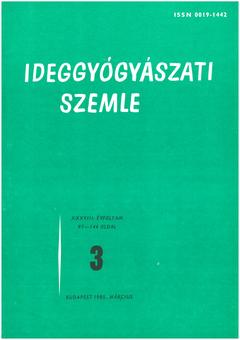The eLitMed.hu medical portal uses computer cookies for convenient operation. Detailed information can be found in the Cookie-policy.
Clinical Neuroscience - 1985;38(03)
Content
[Treatment of intracranial saccular aneurysms]
[In this communication, we report the experience gained in the surgery of saccular aneurysms of the brain, the diagnostic and therapeutic methods used, and in particular the programming of the time of surgery, at the Neurosurgery Clinic of the Pitié Hospital in Paris. From 1970 to 1983, the medical history of 545 patients with saccular aneurysms operated on was reviewed. The conclusions and findings of this report are based on these. ]
[The diagnostic process for psychiatrists experimental approach and comparison]
[The authors have attempted to approach the diagnostic process of 13 psychiatrists using two theoretical constructs - the individual diagnosis schema and the internalized nosological theory - and to compare them using mathematical statistical methods. The results justify the necessity of separating the two concepts and point to the need to pay more attention to implicit theories of analysis that differ significantly between individuals if the reliability of diagnoses is to be increased. It is concluded that treatment preference is only partially and marginally influenced by the diagnostic process and that therapeutic decisions are predominantly determined by other considerations. ]
[Serum level tests to guide modern antiepileptic treatment]
[Based on literature data and the experience of measurements in two of the most relevant laboratories in this field, the authors analyze the usefulness of antiepileptic serum level determinations in guiding antiepileptic treatment. The importance of the kinetic approach is briefly outlined and the basic pharmacokinetic metrics are presented. Using these, they outline the rules for modern drug dosing and drug administration strategies. They point out the possibility of individualized, targeted treatment and the rationale of monotherapy as opposed to the previous polytherapeutic approach. The importance of patient cooperation in treatment and the factors influencing it are stressed. The indications for serum level tests, the basic technical requirements, and the limits of measurement are discussed. In addition to emphasizing the primacy of the clinical picture, the measurement of serum levels of antiepileptic drugs is considered essential in order to better exploit the effects of the drugs.]
[Changes in Rosetta markers in peripheral blood of schizophrenic patients]
[The authors investigated the distribution of lymphocytes in the peripheral blood of schizophrenic patients. They observed a high degree of T lymphocytopenia in untreated forms of the disease and during acute relapses in treated patients. In addition to a decrease in T cell count, the proportion of lymphocyte subpopulations carrying IgG Fc receptor and histamine receptor increased. A moderate increase in B cell numbers was found. No appreciable differences were found in the distribution of peripheral blood lymphocytes between different types of schizophrenia.]
1.
Clinical Neuroscience
[Headache registry in Szeged: Experiences regarding to migraine patients]2.
Clinical Neuroscience
[The new target population of stroke awareness campaign: Kindergarten students ]3.
Clinical Neuroscience
Is there any difference in mortality rates of atrial fibrillation detected before or after ischemic stroke?4.
Clinical Neuroscience
Factors influencing the level of stigma in Parkinson’s disease in western Turkey5.
Clinical Neuroscience
[The effects of demographic and clinical factors on the severity of poststroke aphasia]1.
2.
3.
4.
5.



